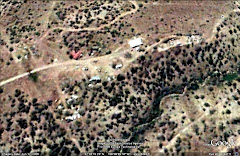
Click on picture for an extreme close-up view.
Artifact discovery by: Robert J. Thomas
The artifact piece pictured above, is a very primitive Pre - columbian ancient Anasazi Shamans Medicine whistle. Hand-crafted of mudstone from Basketmaker I era. (1,000 + B.C.)
{ Mudstone is a sedimentary rock.Through time, originally clay material that has become petrified hardened. It is formed when small particles become deposited over time and the mass of the upper layers exerts pressure on the lower layers, compacting them into rock, to a fine and even texture. Indigenous to the Southwest Colorado 4 corners area.}
The Anasazi of the American Southwest 4 corners region were between the height of less than 5' to 5' 2" with Mongolian features. Accomplished agriculturalists who began a sedentary way of life from nomadic roamers; hunter gatherers, settled in small communities scattered across the Southwest in pit house villages. The structure of their homes called kivas which were sizable circular pits dug in the ground with wooden thatched roof tops, eventually became the center of their religious practices found in numerous locations at Mesa Verde cliff dwellings.
To become a Shaman it takes many years of religious prayer, instruction, and disciplined preparation. The whistle is then passed down to the spiritually attuned Shaman, as it had been traditionally done in the past to other practicing Shaman medicine men for many generations before. Deservingly; he was a highly respected far- seer of spiritual guides, as the whistles resonating pitch sounded to summon the creator of all; 'The great spirit' of important sacred ceremonial religious events.
This ancient whistle is the earliest known primitive wind instrument discovered that is completely intact and in excellent condition, with at least 3 distinct pitches.
This ancient whistle is the earliest known primitive wind instrument discovered that is completely intact and in excellent condition, with at least 3 distinct pitches.
The whistle was discovered by myself which was laid in position on it's side less than 1/4" exposed from the soil surface. The hole was impacted completely full with dirt that had been unknowningly previously dug out 20 years earlier for land development in Southwest Colorado on private property. This Whistle had been buried for many, many hundreds of years.
The ancient Anasazi are thought to have inhabited approximately 40,000 square mile area.
The ancient Anasazi are thought to have inhabited approximately 40,000 square mile area.
As an example of the whistles size in comparison to the known area of occupation of 40,000 square miles; about roughly the size area of the state of Kentucky. There are 21 trillion, 807 billion, 104 million cubic yards ( 3ft.x 3ft.x 3ft. deep ) of potential location possibilities of another find. Could there be another... ? or could it even be possible to even find another ...? This is not likely.
This artifact is the only one known single holed whistle made of mudstone discovered in the Americas. Other multiple holed wind instruments have been recovered at Mesa Verde cliff Dwellings dating from A.D. 1025 - 1325 have been made from two other materials, either stone of a lime chert concretion or bone from large rodents and eagle bone.
This ancient wind instrument was hand chiped with a hole bored completely through at a deliberate angle with a raised air chamber. Slightly larger in size of a U.S. silver dollar, this whistle is thought to have been used for sacred ceremonial and religious prayer rituals.
After extensive research, it is believed that this wind instrument is a predecessor to the Ocarina and Native American flute before music was developed for pleasure and cultural identity. The area of this whistles discovery is approximately 30 miles east of Mesa Verde.
Occupying mesa plateaus and valleys in the area of the LaPlata River and it's tributaries in what is now known as Southwest Colorado.
The Anasazi constructed pit house villages as early as 5,000 B.C., prior to Cliff house dwellings during the early second century.
The Anasazi constructed pit house villages as early as 5,000 B.C., prior to Cliff house dwellings during the early second century.
The eventual arrival of hostile peoples forced the ancient Puebloans from their pit houses to the cliff dwellings. A new style of building begun at around A.D. 600, with multiple level pueblos at Mesa Verde for the advantage of a much more secure location.
To date, acoustically distinct clay instruments have been found in Mexico, Belize, Guatemala, Honduras, Ecuador, and Peru. This mudstone whistle is the only known example in all of North America, with it's Circular shape and primitive one hole design.
The term " Anasazi " is actually a Navajo word; borrowed by Archaeologists meaning, " Ancient enemy or Ancient ones." To the Native Hopi; ' Hisatsinom. '
Blue is considered a sacred color among most Native Americans in the Southwest; representing the color of the blue sky. There is still traces of blue pigment visible despite being buried for many centuries under the soil, remnants of this instrument's true painted color.
Since the Anasazi have no written recorded language, their actual cultural name they called themselves will never be known.
This whistle was used by the highly important of the clan and respected Shaman to heal the sick... in order to secure safe passage to the spirit world; ceremonies for the dead, bountiful harvests, prayers for rain, and prosperous hunting.
(Book ref. Indians in the Americas: The untold story. pg. 134-135 by: Paul Tice ; A book tree publication. )
(Book ref. Indians in the Americas: The untold story. pg. 134-135 by: Paul Tice ; A book tree publication. )
"Whistles are considered by many Archaeologists to be the forerunner of the American Indian flute. The whistle has always been a sacred object. Flutes date back to at least 5,000 years and may have evolved from whistles. They have been found in ancient Greece, and flutes made from pelican bones were discovered in ancient south American pyramids. This ancient Instrument traveled into MesoAmerica and into the Anasazi culture of the southwest area of America."
One of the Greatest mysteries of this whistle and of it's purpose,... " Todays modern man will never be able to truly fathom the meaning and power behind this whistle. Unfortunately, Man has deviated from the understanding of Earth's grand design rhythms and the natural balance of Natures intended order. " R.T.
The Smithsonian Institute has 800 whistles listed in their inventory. There is no record description of a single holed design made from mudstone material.
The Smithsonian Institute has 800 whistles listed in their inventory. There is no record description of a single holed design made from mudstone material.
Published author of a featured article in Ancient American Magazine September's 2007 Issue; Vol. 12 # 75. www.ancientamerican.com/issue75.htm
This whistle can also been seen and heard as a featured story at
viewzone.com/ Anasazi shaman whistle under 'lost history'
or, direct link http://www.viewzone.com/anasazi-whistle.html
For further interest of the acquisition for museum exhibit of this Ancient Anasazi Shaman whistle, contact robertthomas64@excite.com



























.jpg)



































No comments:
Post a Comment